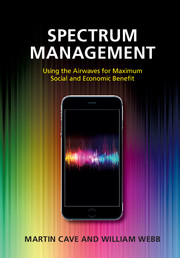Book contents
- Frontmatter
- Contents
- Preface
- Acknowledgments
- Plan of the book
- List of abbreviations
- Part I Fundamentals
- Part II Economic management of spectrum
- Part III Sharing and other emerging approaches to spectrum management
- 8 Spectrum sharing and the commons
- 9 Dynamic spectrum access
- 10 Controlling interference: licensing and receivers
- Part IV Case studies and conclusions
- About the authors
- Index
- References
8 - Spectrum sharing and the commons
from Part III - Sharing and other emerging approaches to spectrum management
Published online by Cambridge University Press: 05 November 2015
- Frontmatter
- Contents
- Preface
- Acknowledgments
- Plan of the book
- List of abbreviations
- Part I Fundamentals
- Part II Economic management of spectrum
- Part III Sharing and other emerging approaches to spectrum management
- 8 Spectrum sharing and the commons
- 9 Dynamic spectrum access
- 10 Controlling interference: licensing and receivers
- Part IV Case studies and conclusions
- About the authors
- Index
- References
Summary
Basic approach to commons
Defining spectrum commons
Spectrum bands that do not need a license are said to be “unlicensed” or “license-exempt.” Another term for this is “spectrum commons,” drawing a parallel with common land, where all are allowed (historically this was used to graze animals). In these bands anyone can transmit as long as they obey a few rules of access, such as maximum power levels. The most popular commons band is at 2.4 GHz, which is used for Wi-Fi, Bluetooth and other similar applications.
Where an unlicensed approach may work
Spectrum regulators have noted that they should not license users where there is no concern about interference. This would be the case where there is more capacity in the radio spectrum than demand and where there are mechanisms for users to self-co-ordinate in some manner to avoid interfering with each other. For many applications there are significant concerns about interference, but there are some special cases. In particular these include:
• Low-power transmissions where signals do not extend very far and so have limited chances of interference.
• Very high frequencies (e.g. above about 40 GHz) where there are large amounts of bandwidth and limited demand because of poor propagation at these frequencies.
• Constrained environments such as indoor operation where the exterior of the building can provide some shielding such that one user does not interfere with another.
• In fixed links where the radio signals are generated as thin beams which are much less likely to interfere with each other than omni-directional transmissions.
• In areas where technology can perform the co-ordination and arbitration of usage. These might be expected to grow over time as technology advances, and various approaches are discussed in this and subsequent chapters.
To date, unlicensed approaches tend to be a mix of both higher frequencies (mostly above 2 GHz) and lower powers (mostly below 100 mW), resulting in low range. This has led to hundreds of different applications and technologies including Wi-Fi, Bluetooth, cordless phones, garage door openers, baby monitors, and much more.
Basic approach to the commons
Regulation of commons, or unlicensed spectrum, is rather like regulation of a park. In a park anyone is allowed in as long as they behave themselves.
Information
- Type
- Chapter
- Information
- Spectrum ManagementUsing the Airwaves for Maximum Social and Economic Benefit, pp. 149 - 161Publisher: Cambridge University PressPrint publication year: 2015
